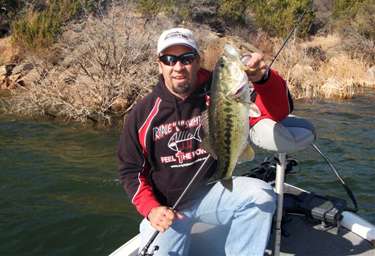
They say everything’s big in Texas, and the Lone Star State can certainly claim a healthy share of large bass. Ben Kirkpatrick of Wolfforth, Texas, knows all about that.
He’s even developed his own unique way to catch them. “I’ve fished tournaments for much of my adult life,” said the 41-year-old father of three boys. “When I started catching big Florida strain bass at O.H. Ivie Reservoir, I was instantly hooked and looked for the best ways to catch them.” Kirkpatrick said he caught some heavy largemouths on conventional Carolina and Texas rigged plastics, as well as on big spinnerbaits, but he wanted more. “I caught a 9-pound, 15-ounce bass before picking up swimbaits.
I really wanted to break the 10-pound mark,” he said. “I came across Optimum swimbaits, and started working on ways to make big fish bite.”
When the city of Lubbock built the 2,400-acre Alan Henry Lake, the combination of the new reservoir and big swimbaits began producing serious results. “I was using 4- to 8-inch Optimums with the internal lead head, and I would rip them off the bottom like I was stroking a jig,” Kirkpatrick said.
“I started seeing bigger bites, and when I caught my personal best (a 14-1 behemoth), I knew I was on the right track.” His technique mimics the aggressive sweeping of a jig or big flutter spoon off the bottom in an attempt to generate a reaction strike from nearby bass.
He uses a big rod and heavy line to manipulate and control the big baits. He said the keys are locating the proper areas and maintaining touch with his lure. “I try to locate long points and offshore humps that hold big bass,” he said. “They can be fairly shallow in stained water, or deeper in clear water, but they will hold off those types of structure and will often respond to a swimbait ripped off the bottom.
” Most Texas bass waters are stained, and Kirkpatrick uses water color to make his line choice. “I prefer to use braided line in off-colored water — usually 50-pound-test,” he said. “But, if I’m on a clear water lake, such as Amistad, I switch to 25-pound-test fluorocarbon.”
He uses both on a 6.3:1 reel and a 7 1/2-foot heavy-action flipping rod. He makes the baits himself. Kirkpatrick is the owner of Triple J Swimbaits, a company he named after his three young sons (Jake, Jordan and Jackson). He makes several styles of swimbaits, including flat-topped boot tail baits that give anglers the ability to change the internal weight.
He uses a different type of bait, one he calls the Two-J for his stroking technique. “The Two-J is similar to other paddletail-type swimbaits in that I rig it on a weighted wide gap hook,” he said. “I use this rig to cover the bottom because it comes through brush and over obstructions really well.”
He rigs the bait on a 10/0 Owner Beast with a 1/2-ounce weight on the shank. If the water isn’t very deep, he uses a Lake Fork Trophy Lures swimbait hook in the same size with a 3/8-ounce weight. The heavier weights create the kind of feel and action he needs.
“I want to feel the tail thumping when I pick it up off the bottom, and I move the bait as much as 3 feet on each lift,” he said. “I follow the fall of the lure down with my rod tip to control the fall and to be ready to set the hook when they strike. He said the strikes are often vicious, and he reacts immediately by setting the hook as hard as he can. Kirkpatrick said the approach is addictive, and warns others to be careful. “I got hooked immediately, and I’m a messed up swimbait fisherman now.
The motto “go big or go home” is one I’ve adopted, and it’s resulted in 15 bass over 10 pounds for me, and dozens of fish over 8 pounds.” You can find Triple J Swimbaits at www.triplejswimbaits.com.





